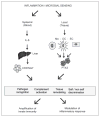Pattern recognition by pentraxins
- PMID: 19799114
- PMCID: PMC3367411
- DOI: 10.1007/978-1-4419-0901-5_7
Pattern recognition by pentraxins
Abstract
Pentraxins are a family of evolutionarily conserved pattern-recognition proteins that are made up of five identical subunits. Based on the primary structure of the subunit, the pentraxins are divided into two groups: short pentraxins and long pentraxins. C-reactive protein (CRP) and serum amyloid P-component (SAP) are the two short pentraxins. The prototype protein of the long pentraxin group is pentraxin 3 (PTX3). CRP and SAP are produced primarily in the liver while PTX3 is produced in a variety of tissues during inflammation. The main functions of short pentraxins are to recognize a variety of pathogenic agents and then to either eliminate them or neutralize their harmful effects by utilizing the complement pathways and macrophages in the host. CRP binds to modified low-density lipoproteins, bacterial polysaccharides, apoptotic cells, and nuclear materials. By virtue of these recognition functions, CRP participates in the resolution of cardiovascular, infectious, and autoimmune diseases. SAP recognizes carbohydrates, nuclear substances, and amyloid fibrils and thus participates in the resolution of infectious diseases, autoimmunity, and amyloidosis. PTX3 interacts with several ligands, including growth factors, extracellular matrix component and selected pathogens, playing a role in complement activation and facilitating pathogen recognition by phagocytes. In addition, data in gene-targeted mice show that PTX3 is essential in female fertility, participating in the assembly of the cumulus oophorus extracellular matrix. PTX3 is therefore a nonredundant component of the humoral arm of innate immunity as well as a tuner of inflammation. Thus, in conjunction with the other components of innate immunity, the pentraxins use their pattern-recognition property for the benefit of the host.
Figures


Similar articles
-
The long pentraxin PTX3 in vascular pathology.Vascul Pharmacol. 2006 Nov;45(5):326-30. doi: 10.1016/j.vph.2006.08.011. Epub 2006 Aug 23. Vascul Pharmacol. 2006. PMID: 17023219 Review.
-
Pentraxins in innate immunity: from C-reactive protein to the long pentraxin PTX3.J Clin Immunol. 2008 Jan;28(1):1-13. doi: 10.1007/s10875-007-9126-7. Epub 2007 Sep 9. J Clin Immunol. 2008. PMID: 17828584 Review.
-
Pentraxins and atherosclerosis: the role of PTX3.Curr Pharm Des. 2011;17(1):38-46. doi: 10.2174/138161211795049750. Curr Pharm Des. 2011. PMID: 21226667 Review.
-
Pentraxins: multifunctional proteins at the interface of innate immunity and inflammation.Biofactors. 2009 Mar-Apr;35(2):138-45. doi: 10.1002/biof.21. Biofactors. 2009. PMID: 19449441 Review.
-
Pentraxins at the crossroads between innate immunity, inflammation, matrix deposition, and female fertility.Annu Rev Immunol. 2005;23:337-66. doi: 10.1146/annurev.immunol.23.021704.115756. Annu Rev Immunol. 2005. PMID: 15771574 Review.
Cited by
-
Structure-activity relationships in human Toll-like receptor 8-active 2,3-diamino-furo[2,3-c]pyridines.J Med Chem. 2012 Sep 27;55(18):8137-51. doi: 10.1021/jm301066h. Epub 2012 Sep 7. J Med Chem. 2012. PMID: 22924757 Free PMC article.
-
mCRP-Associated Vascular Pathophysiology in Progression and Outcome of Intracerebral Hemorrhage.Int J Mol Sci. 2025 Jun 27;26(13):6195. doi: 10.3390/ijms26136195. Int J Mol Sci. 2025. PMID: 40649973 Free PMC article. Review.
-
Metaproteomic assessment of gut microbial and host functional perturbations in Helicobacter pylori-infected patients subjected to an antimicrobial protocol.Gut Microbes. 2023 Dec;15(2):2291170. doi: 10.1080/19490976.2023.2291170. Epub 2023 Dec 8. Gut Microbes. 2023. PMID: 38063474 Free PMC article.
-
Oct-1 acts as a transcriptional repressor on the C-reactive protein promoter.Mol Immunol. 2012 Oct;52(3-4):242-8. doi: 10.1016/j.molimm.2012.06.005. Epub 2012 Jun 29. Mol Immunol. 2012. PMID: 22750226 Free PMC article.
-
Anti-inflammatory actions of serine protease inhibitors containing the Kunitz domain.Inflamm Res. 2010 Sep;59(9):679-87. doi: 10.1007/s00011-010-0205-5. Epub 2010 May 8. Inflamm Res. 2010. PMID: 20454830 Review.
References
-
- Garlanda C, Bottazzi B, Bastone A, et al. Pentraxins at the crossroads between innate immunity, inflammation, matrix deposition, and female fertility. Annu Rev Immunol. 2005;23:337–366. - PubMed
-
- Volanakis JE. Human C-reactive protein: Expression, structure, and function. Mol Immunol. 2001;38:189–197. - PubMed
-
- Black S, Kushner I, Samols D. C-reactive protein. J Biol Chem. 2004;279:48487–48490. - PubMed
-
- Skinner M, Cohen AS. Amyloid P component. Methods Enzymol. 1988;163:523–536. - PubMed
Publication types
MeSH terms
Substances
Grants and funding
LinkOut - more resources
Full Text Sources
Research Materials
Miscellaneous

